How I Chose the Best Slow Feeder for My Horse
During that time I bought, designed, built and prototyped a variety of slow feeders and slow feed hay bags for my and Lily's use. Following are the pros and cons I discovered while experimenting with my own version of each slow feeder type: hard-sided, webbing mesh, and netting.
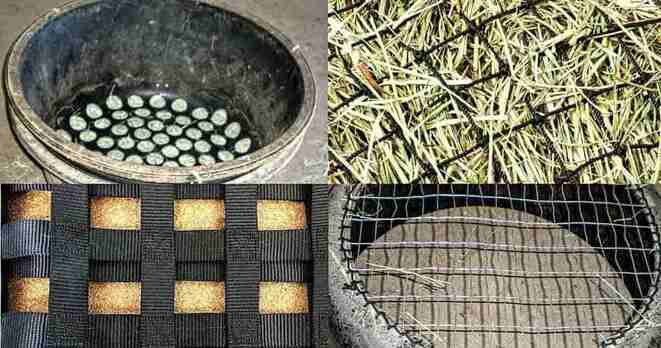
Why I'm Sharing My Experience
I know what it's like to want the best for your equine partner, to embark on an exploratory journey, and to be overwhelmed in the process. For those of you who are new to slow feeding free choice forage - or are still experimenting with finding the best slow feeders to accommodate a 24/7 feeding protocol - I offer my findings and lessons learned in hopes the information may help you in your journey.
My Evaluation Criteria
- How effective the feeders were.
- Ease of loading/transport - I wanted the ability to offer numerous feeding stations to encourage movement that were quick to load and not burdensome to distribute.
- Potential harm to the horse. Harm can occur from pilot error regardless of the slow feeder device. For example: 1) An opening size that is too small causing frustration, subsequently forcing your equine to scrape their teeth across an abrasive surface to extract hay; 2) Over loading/packing hay too tight making it difficult to access; and 3) Anxious meal fed individuals with little to no patience who can damage a feeder and/or injure themselves.
Full Disclosure - While we ultimately determined netting was the most effective for slow feeding, both hard-sided and webbing mesh devices are successful for many. We are not discouraging their use as long as they are effective, encourage movement and cause no harm!
Hard Sided Slow Feeders
- Effectiveness - My experience was that both of these either fed too fast or the horses could not eat at all with smaller openings because the ends of the hay were flattened. There was no in between in regards to rate of consumption.
- Ease of loading and transporting - Loading with hay was fairly quick, although I needed to use a wheel barrow to cart them around due to the weight and size. Ability to offer numerous locations was expensive and time consuming.
- Potential harm - The feeder on the left with holes has the ability to wear enamel off teeth and metal grates on the right can cause grooves in teeth.
Webbing Mesh
- Effectiveness - My experience was that it fed too fast or the horses could not eat at all with smaller openings because the surface area is reduced and the ends of the hay were flattened. There was no in between in regards to rate of consumption. The majority of these bags have the opening at the top, which may allow access to large mouthfuls of hay. This dilemma is often mitigated by hanging the bag higher, requiring your equine to eat in a very awkward posture.
- Ease of loading and transporting - Loading the hay was easy. Ability to offer numerous locations can be challenging if you don't have fences or trees to hang them from.
- Potential harm - This material has the ability to wear enamel off teeth if the horse is required to scrape his teeth across the webbing to extract hay. If the mesh size is large enough to pull hay out with the lips, it may feed too fast for some but this does preserve the enamel.
Netting
- Effectiveness - Netting enables the horse to use his lips and teeth - experiencing the most natural way to gather and consume forage. Netting inherently provides more surface area to nibble from and conforms to the hay. If loaded properly (not too full), your horse can manipulate and gather the hay with his lips and extract it with his teeth (see video demonstration below). Ensures no cheating via foolproof drawstring or zipper closures.
For barefoot individuals, the Standard Hay Pillows, Mini Hay Pillows and slow feed hay nets are appropriate for use on the ground. Hanging nets/bags for barefoot individuals should be hung as low as possible to allow a more natural grazing position. For shod equines, hay nets/bags should be hung out of strike range and never used on the ground to prevent ensnarement. - Ease of loading and transporting - Quick to load and transport. Ability to offer numerous locations - the Standard and Mini Hay Pillows (for barefoot equines only) require no mounting. Simply toss on the ground anywhere!
- Potential harm - Has the ability to wear enamel off teeth only if the bag or net is filled too tight or the mesh size is too small. Loose fill and appropriate mesh size allow manipulation and gathering ends of the hay with lips. See our Slow Feed Solutions By Enclosure Type & Weather Condition page to explore a variety of options for shod and barefoot horses.
Why Netting Was Most Effective
- It has more surface area and conforms to the hay enabling ends to protrude - which allows for lip engagement as the hay is gathered (see demonstration video below)
- Allows a smaller opening to slow the gathering of hay without frustration - and without requiring the individual to scrape teeth across an abrasive surface to extract hay.
- Easy to load.
- Lightweight.
- Requires little to no preparation to provide multiple feeding stations.
- Foolproof closures, no cheating!
There You Have It - 4 Years of Prototyping and 15+ Years of Slow Feeding!
The icing on the cake? I'm no longer a prisoner of feeding because I devised a methodical healthy way to offer slow fed free choice forage and have a career I'm super passionate about. Here's to happier, healthier horses!
More Helpful Slow Feed Resources
- Beyond Low Sugar/Starch - Choosing Hay for Weight Management
- Free Choice Forage Action Plan
- Slow Feeding Fails - Avoid These Common Misconceptions
- Are You a Prisoner of Feeding? Here's How I Broke Free
- Feeding Miniature Horses & Donkeys: Why Slow Fed Forage is Best
- 6 Great Reasons to Feed Your Horse from Ground Level
- 9 Benefits of Slow Feeding Horses
- 7 Slow Feed Dos and Don'ts for Horses
- 7 Easy Ways to Help Prevent Colic
- Never Exercise Horses on an Empty Stomach...Ever
- Why You Shouldn't Transport Horses On An Empty Stomach
- Keeping Horses Warm Naturally – Internally and Externally
- Why Most Horse Prefer to Eat Outside
- Sand Colic - The Surprising (Simple) Cure & Prevention
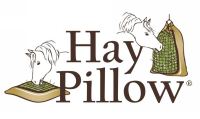
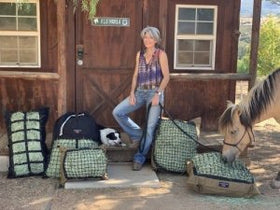
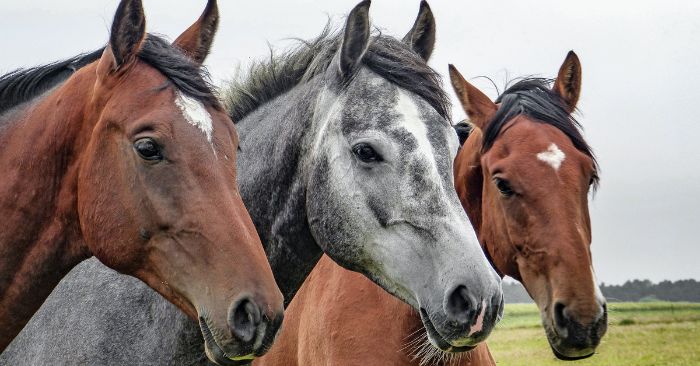
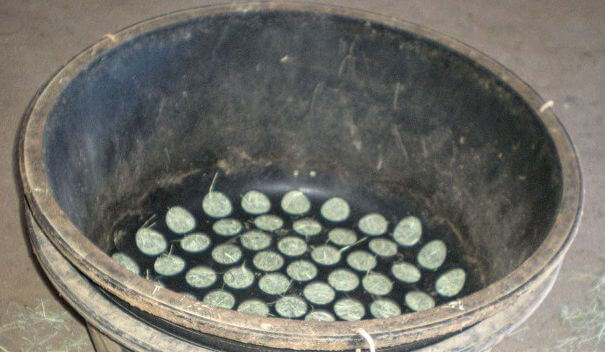
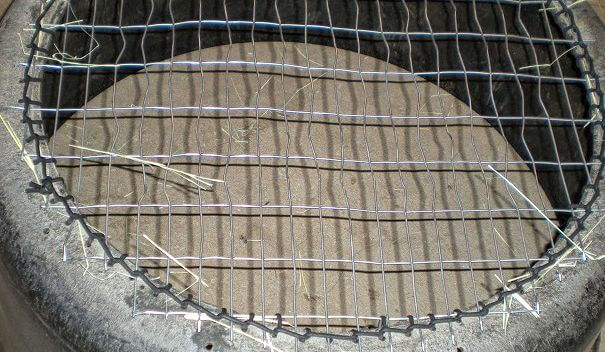
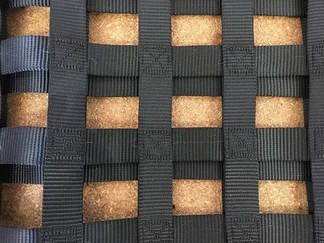
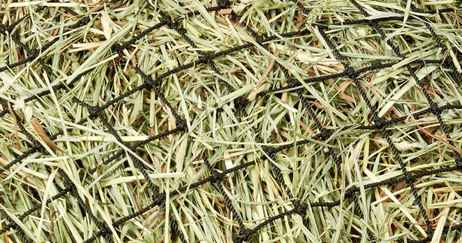

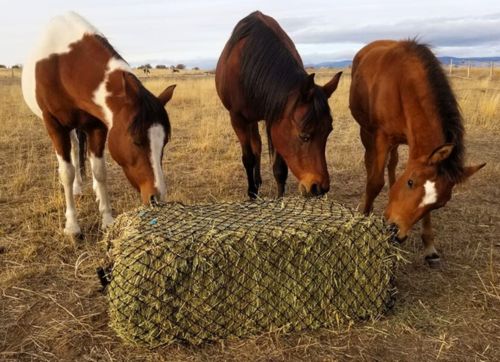


3 Comments -
Hay Pillow Inc • -
Diann • -
Diann •
Hi Diann,
We offer 4 mesh sizes. The most popular mesh size for most, including older equines is the 1 3/4" mesh. Review our blog post Slow Feeding – Transition Tips & Techniques and our Choosing A Mesh Size page.
I have 2 very old horses one. Yes? Way in. Her? 30s and 1 is 30.
What size webbing do you offer?
I have 2 very old horses one. Yes? Way in. Her? 30s and 1 is 30.
What size webbing do you offer?